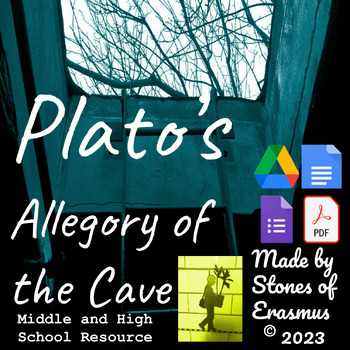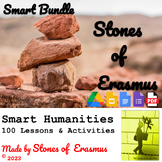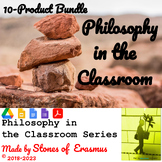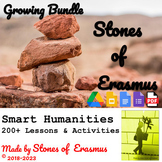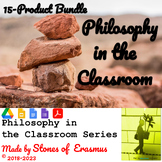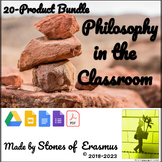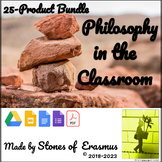Plato Explained: Allegory of the Cave in Plain Language for Students Middle & HS
- Google Drive™ folder
- Easel Activity
- Easel Assessment

Also included in
- Expand your offerings and broaden the scope of a humanities curriculum for middle and high school with☝100 educational units! Entirely print + digital — Adobe Acrobat and Google Workspace power each download. Extra addition: Includes free-to-use out-of-the-box Easel Activities and Easel AssessmentsPrice $350.00Original Price $470.10Save $120.10
- I've combined five compelling Plato & Nietzsche resources I use in my middle and high school classes to infuse my lessons with philosophy and ethics-based content.With this bundle, you get the following:Plato's Allegory of the Cave Lesson ResourceIntroduce your students to this imaginative allegPrice $19.00Original Price $28.00Save $9.00
- I've combined ten compelling resources I use in middle and high school classes to infuse my lessons with philosophy and ethics-based content.With this bundle, you get the following:1. Plato's Allegory of the Cave Lesson ResourceIntroduce your students to this imaginative allegory about humankind's sPrice $30.00Original Price $46.00Save $16.00
- Everything related to broadening the scope of a humanities curriculum for middle and high school is included in this growing bundle.☝211 and growing educational units! Entirely print + digital — Adobe Acrobat and Google Apps power each download. Extra addition: Includes free-to-use out-of-the-box EaPrice $590.00Original Price $906.85Save $316.85
- What is justice? What is really real? Why is Socrates always running around the city finding random people to talk to? Answer these questions and more — by jumping into one of the most intriguing conversations ever recorded! Based on reading excerpts from Plato's Republic, engage middle and high schPrice $20.00Original Price $30.50Save $10.50
- What is the meaning of life? What is really real? Why is Socrates talking to random people? How do I know I am not dreaming right now? What if I could do anything I wanted without fear of punishment? What is the marshmallow test? How can I take really good notes in class? We've combined fifteen compPrice $40.00Original Price $57.50Save $17.50
- Myth is not philosophy, but philosophers often use myths! Introduce middle and high school kids to five fascinating philosophical myths. I've combined five compelling myths from Greek Mythology, Plato, and the German philosopher Friedrich Nietzsche that I use in my middle and high school classes toPrice $24.00Original Price $36.35Save $12.35
- Use a 4-Lesson Plato's "Allegory of the Cave" Mini-Unit and Activity Bundle to teach Plato to young people and ensure a jam-packed week of fun games and formative and summative assessments, and more. I was inspired to create this bundled resource when I noticed the popularity of my retelling of PlatPrice $8.00Original Price $11.50Save $3.50
- What is love? What is virtue? What is the meaning of life? What is really real? Why is Socrates talking to random people? Who is Glaucon and Protagoras, and why should it matter if I am in a cave? How do I know I am not dreaming right now? What if I could do anything I wanted without fear of punishmPrice $51.00Original Price $78.00Save $27.00
- What is love? What is virtue? What is the meaning of life? What is real? Why is Socrates talking to random people? Who are Glaucon, Protagoras, and why should it matter if I am in a cave or not? How do I know I am not dreaming right now? What if I could do anything I wanted without fear of punishmenPrice $70.00Original Price $105.50Save $35.50
- Explore the Foundations of Justice with Plato's Republic. Dive into the heart of one of history's most profound philosophical inquiries: "What is justice?" Join Socrates and his companions on their iconic stroll through the streets of ancient Athens, as they engage in riveting discussions and thoughPrice $30.00Original Price $45.00Save $15.00
Description
If you want to teach philosophy to young people, use this lesson plan that introduces students to Plato's theory of reality. I was inspired to create this resource when I retold the story of Plato's allegory of the cave (from The Republic) in plain language. In this story, Plato imagines a world where one man wakes up and questions what is real and what is not real. Have your students read this story with you and use my handy dandy comprehension questions and discussion activities to lead your students into an examination of Plato's metaphysical thinking.
This resource contains the following features:
PDF, Google Workspace, Easel Activity, and Assessment
Essential Question: How do I know what is really real?
- The text of the story is included in this resource
- The story is retold from the source material in easy-to-understand English. Great for a class read-and-share. Or have students pair-read the text and then have a whole-class discussion.
- 15 Reading Comprehension Questions
- Useful for homework. Or, to flip the classroom — assign the reading before you plan to discuss and have students complete the reading comprehension questions beforehand.
- 6 Discussion Questions
- Perfect for group work or a carousel activity — get your kids moving while discussing Plato!
- 3 Google Form Self-Checking Assessments!
- Look! Easel Activity and Assessment Included!
- A Chart to Explain Plato's Two-World Theory
- Useful graphic organizer to understand Plato's worldview
- Answer key for both comprehension and discussion questions
- Suggested Lesson Plan
- With more ideas and instructions on how to use this resource
- Bibliography
- I use the bibliography as a further reading resource for my students. Assign your curious scholars a research assignment or have students do projects based on books, links, and other material related to Plato they may find interesting or exciting.
Suggested Uses:
- Humanities Course on Ancient Greece
- World History Course on the History of Ideas
- Literature Course
- Ethics Course — See how I used this resource in an Ethics class with 8th graders!
- Introduction to Philosophy Course
- Student Advisory Course on Drug and Alcohol Abuse
- A Lesson on Truth
- A Lesson on Appearance and Reality
Discover More of My Philosophy in the Classroom Series
✰ See the companion lesson "The Ring of Gyges" on the uses and misuses of justice from Plato's Republic.
✰ 5-product Philosophy in the Classroom bundle — Includes this resource, Ringof Gyges, Nietzsche, Empiricism, and Rationalism, and activity to Discuss any Moral Problem.
Check out my website to follow me on my journey: stonesoferasmus.com. I often blog about books, teaching, art, and cherished journals and rants. © 2023

